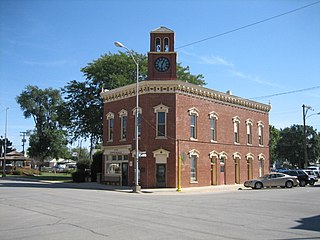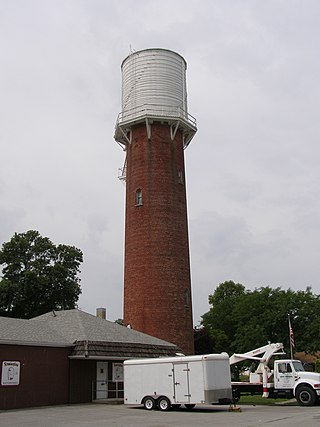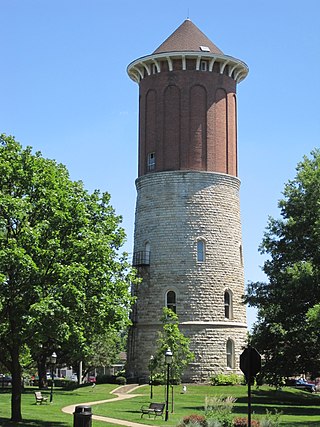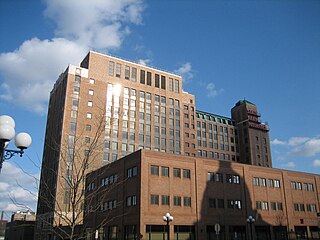
Ransom is a village in LaSalle County, Illinois, United States. The population was 308 at the 2020 census, down from 384 at the 2010 census. It is part of the Ottawa Micropolitan Statistical Area. It is part of the subregion known as Streatorland.

Grimsby Dock Tower is a hydraulic accumulator tower and a maritime landmark at the entrance to the Royal Dock, Grimsby, in North East Lincolnshire, England. It was completed on 27 March 1852, based on William Armstrong's idea of the hydraulic accumulator, with the purpose of containing a 30,000-imperial-gallon (140,000 L) reservoir at a height of 200 feet (61 m), that was used to provide hydraulic power to power the machinery of the Grimsby Docks. The extreme height of the tower was necessary to achieve sufficient pressure, and as a result of this, the tower can be seen for several miles around, even far inland on the north bank of the Humber estuary in villages such as Patrington.

Thomas Hill Standpipe, which holds 1,750,000 US gallons (6,600,000 L) of water, is a riveted wrought iron tank with a wood frame jacket located on Thomas Hill in Bangor, Maine, United States. The metal tank is 50 feet (15 m) high and 75 feet (23 m) in diameter. Built in 1897, it is an architecturally distinctive city landmark, and was listed on the National Register of Historic Places in 1974.

Greens Ledge Lighthouse is a historic offshore lighthouse in the western Long Island Sound near Norwalk, Connecticut and Darien, Connecticut. It is one of 33 sparkplug lighthouses still in existence in the United States and remains an active aid to navigation. It sits in ten feet of water on the west end of Greens Ledge, a shallow underwater reef that runs a mile west of Sheffield Island and is roughly a mile south of the entrance to Five Mile River at Rowayton. Completed in 1902 by the Philadelphia Construction Company, the cast-iron structure is approximately 90 feet tall including roughly 15 feet of the submerged caisson. In 1933, more than 30,000 tons of rocks from the excavation of Radio City Music Hall were added to the riprap foundation. The light was added to the National Register of Historic Places as Greens Ledge Lighthouse on May 29, 1990.

The Ellwood House was built as a private home by barbed wire entrepreneur Isaac Ellwood in 1879. It is located on First Street in DeKalb, Illinois, United States, in DeKalb County. The Victorian style home, designed by George O. Garnsey, underwent remodeling in 1898-1899 and 1911. The house was originally part of 1,000 acres (4.0 km2) which included a large stable complex known as "Ellwood Green." Isaac Ellwood lived here until 1910 when he passed the estate to his son, Perry Ellwood.

Buffalo Grove Lime Kiln is one of two old lime kilns in Illinois listed on the National Register of Historic Places. The other is the Griggsville Landing Lime Kiln in Pike County. Buffalo Grove Lime Kiln is located near the Ogle County city of Polo. When in use, the kiln would have produced raw quicklime. The lime kiln was added to the National Register in 2002.

St. Clair Flats Front and Rear Range Light are two lighthouse structures situated off the southeastern tip of Harsens Island at Lake St. Clair.

The Lena Water Tower is a water tower located in the village of Lena, Illinois, United States. It was built in 1896 following two decades of problems with structure fires in the village. The current water tower is the result of a second attempt after the first structure proved to be unstable. The tower stands 122.5 feet (37.3 m) tall and is built of limestone and red brick. The current stainless steel water tank holds 50,000 gallons and replaced the original wooden tank in 1984. The site has two other structures, an old power plant building and a 100,000 US gallon reservoir. The Lena Electric Plant Building was constructed in 1905 and the reservoir completed in 1907. The Lena Water Tower was listed on the U.S. National Register of Historic Places in 1997; the reservoir was included as a contributing property to the listing.

The John R. Oughton House, commonly known as The Lodge or the Keeley Estate, is a Victorian mansion located in the village of Dwight, Illinois, United States. The grounds remain mostly unchanged since the house was moved from its original site in 1894 and remodeled a year later. John R. Oughton occupied the house until his death in 1925, and in 1930, the house became a boarding home for patients of the internationally known Keeley Institute. The Keeley Institute was founded in 1879, in part by Oughton, and utilized a new form of treatment for alcoholism. The estate grounds feature two outbuildings, a carriage house and a windmill, as well as a pond. Since 1978, the Oughton House has been occupied by a private restaurant, but the windmill is owned by the Village of Dwight, and the carriage house is a public library. The Oughton House and its outbuildings were added to the U.S. National Register of Historic Places in 1980.

Central House is an 1860s hotel building located in the 800-person village of Orangeville, in Stephenson County, Illinois, United States. The building was built by Orangeville founder John Bower and operated as a hotel from its construction until the 1930s, when it was converted for use as a single family residence. The three-story building was the first commercial brick structure in downtown Orangeville. Architecturally, the building is cast in a mid-19th-century Italianate style. Central House was added to the U.S. National Register of Historic Places in 1999.

Fairbury City Hall is a historic city hall in Fairbury, Illinois, United States. It was constructed in 1892 with a clock tower that was added in 1912 as a gift from local business owners. The building was added to the U.S. National Register of Historic Places in 1996.

Washington Park Historic District, also known as Washington Square is a historic district in and around Washington Park in the city of Ottawa, Illinois, United States. Washington Park was the site of the first Lincoln-Douglas debates of 1858 and is surrounded by several historic structures. The park was platted in 1831 and the historic district was added to the United States National Register of Historic Places in 1973.

The Water Tower was built in 1897 by Challenge Wind and Feed mill Company of Batavia, Illinois. This is a rare wooden tank atop a brick tower type of water tower. Built on a limestone foundation, it is 140 feet (43 m) tall and about 20 feet (6.1 m) in diameter. The brick walls are 2 feet (0.61 m) thick.

The Western Springs Water Tower is a museum and former water tower in Western Springs, Illinois. The water tower is considered a symbol of Western Springs by residents, and multiple businesses and local organizations have taken their names from the tower. It was added to the National Register of Historic Places on June 4, 1981.

The Benson Water Tower was a water tower located on Clayton Street in Benson, Illinois. The tower was built in 1891, in response to several serious fires in Benson; it supplied the village with water until 1985. The tall brick tower had a large wooden water tank on top. The tower was added to the National Register of Historic Places in 1987. It has since been demolished, and was delisted in 2020.

The State Farm Downtown Building, variously known as the State Farm Insurance Building or the State Farm Fire Building, is an Art Deco building in downtown Bloomington, Illinois. It served as the corporate headquarters for State Farm Insurance from its construction until 1974.

The Monroe Water Tower is a historic water tower built in 1889 in Monroe, Wisconsin. It was added to the National Register of Historic Places in 2005.

The West Water Tower and Ground Storage Tank are a historic water tower and storage tank located at 310 11th Avenue in Orion, Illinois. The tower and tank were built in 1928 as part of the village's new water system, which had been approved the previous year. The water system was introduced both as a response to several fires which had plagued the village and as an effort to bring modern technology and progress, among other civic concerns. The water tower consists of a steel tank with a hemispherical bottom supported by a steel trestle; the structure is 136.5 feet (41.6 m) tall. The ground storage tank, located at the base of the tower, is made of redwood and holds 30,000 US gallons of water.

The Ogilvie Watertower is a historic water tower in Ogilvie, Minnesota, United States, built in 1918. It was listed on the National Register of Historic Places in 1980 for having local significance in the themes of engineering and social history. It was nominated for being a rare surviving example of Minnesota's earliest reinforced concrete water towers and a symbol of the local infrastructure improvements that enabled the organization of Ogilvie's fire department.

The Keweenaw Waterway Upper Entrance Light is a lighthouse located at the north end of the Portage River in McLain State Park in Hancock Township, Michigan. It was listed on the National Register of Historic Places in 2014.






















